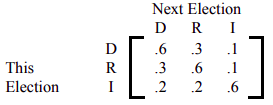10.1.1: Introduction to Markov Chains (Exercises)
- Page ID
- 37934
\( \newcommand{\vecs}[1]{\overset { \scriptstyle \rightharpoonup} {\mathbf{#1}} } \) \( \newcommand{\vecd}[1]{\overset{-\!-\!\rightharpoonup}{\vphantom{a}\smash {#1}}} \)\(\newcommand{\id}{\mathrm{id}}\) \( \newcommand{\Span}{\mathrm{span}}\) \( \newcommand{\kernel}{\mathrm{null}\,}\) \( \newcommand{\range}{\mathrm{range}\,}\) \( \newcommand{\RealPart}{\mathrm{Re}}\) \( \newcommand{\ImaginaryPart}{\mathrm{Im}}\) \( \newcommand{\Argument}{\mathrm{Arg}}\) \( \newcommand{\norm}[1]{\| #1 \|}\) \( \newcommand{\inner}[2]{\langle #1, #2 \rangle}\) \( \newcommand{\Span}{\mathrm{span}}\) \(\newcommand{\id}{\mathrm{id}}\) \( \newcommand{\Span}{\mathrm{span}}\) \( \newcommand{\kernel}{\mathrm{null}\,}\) \( \newcommand{\range}{\mathrm{range}\,}\) \( \newcommand{\RealPart}{\mathrm{Re}}\) \( \newcommand{\ImaginaryPart}{\mathrm{Im}}\) \( \newcommand{\Argument}{\mathrm{Arg}}\) \( \newcommand{\norm}[1]{\| #1 \|}\) \( \newcommand{\inner}[2]{\langle #1, #2 \rangle}\) \( \newcommand{\Span}{\mathrm{span}}\)\(\newcommand{\AA}{\unicode[.8,0]{x212B}}\)
SECTION 10.1 PROBLEM SET: INTRODUCTION TO MARKOV CHAINS
|
|
|
|
- A survey of American car buyers indicates that if a person buys a Ford, there is a 60% chance that their next purchase will be a Ford, while owners of a GM will buy a GM again with a probability of .80. The buying habits of these consumers are represented in the transition matrix below.

Find the following probabilities:
|
|
|
|
- Professor Hay has breakfast at Hogee's every morning. He either orders an Egg Scramble, or a Tofu Scramble. He never orders Eggs on two consecutive days, but if he does order Tofu one day, then the next day he can order Tofu or Eggs with equal probability.
|
|
|
|
- A professional tennis player always hits cross-court or down the line. In order to give himself a tactical edge, he never hits down the line two consecutive times, but if he hits cross-court on one shot, on the next shot he can hit cross-court with .75 probability and down the line with .25 probability.
|
|
- The transition matrix for people voting for candidates from various political parties in an election year is given below. If a person votes for the candidate from one party in an election, that person may vote for the same party in the next election or may switch to vote for a candidate from another party in the next election. Democrats, Republicans, and Independents are denoted by the letters D, R, and I.

Assume there is an election every year so that the transition period is 1 year.
|
|
|
|


